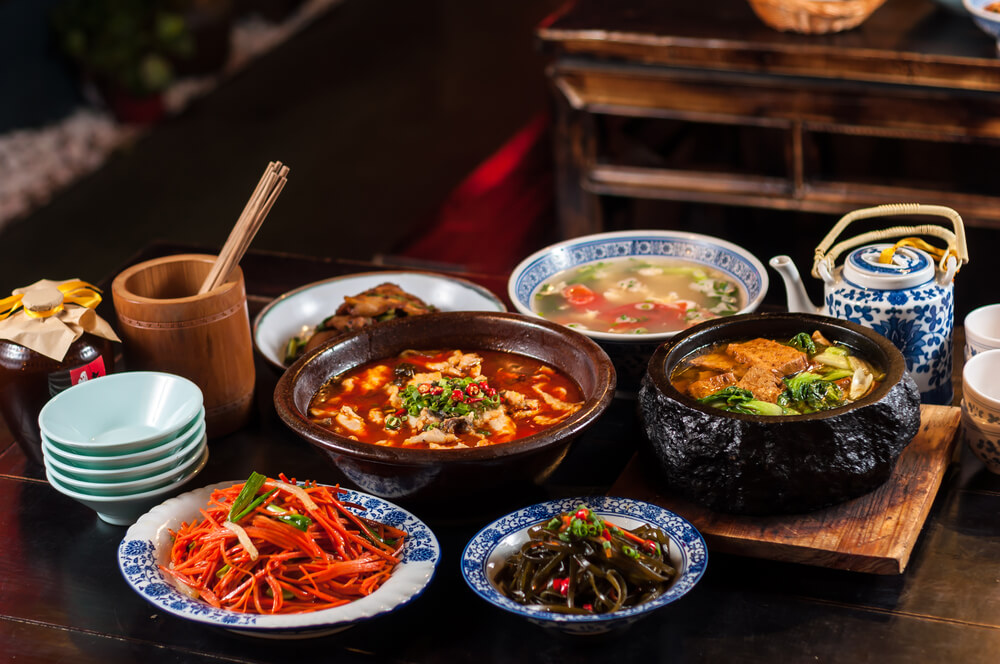
Of the eight great traditions of Chinese cuisine, Sichuan cuisine is perhaps the most popular. Originating in Sichuan Province of western China, Sichuan cuisine enjoys an international reputation for being spicy and flavorful. Yet the highly distinctive pungency (辛辣) is not its only characteristic. In fact, Sichuan cuisine has a variety of flavors and different methods of cooking, featuring the taste of hot, sweet, sour, salty, or tongue-numbing.
The origin of Sichuan cuisine can date back to the Qin and Han dynasties, and its recognition as a distinct regional system took place in the Han Dynasty. As a unique style of food, Sichuan cuisine was famous more than 800 years ago during the Southern Song Dynasty when Sichuan restaurants were opened in Lin’an, now called Hangzhou, the capital. The hot pepper was introduced into China from South America around the end of the 17th century. Once it came to Sichuan, it became a favored food flavoring. In the late Qing Dynasty around the 19th century, Sichuan cuisine became a unique local flavor, enjoying the same reputation as Shandong, Guangdong, and Huaiyang cuisines.
Sichuan has many rainy or cloudy days. Hot pepper helps reduce internal dampness, so it was used frequently in dishes, and hot dishes became the norm in Sichuan cuisine. The region’s warm and wet climate also requires complex food-preservation techniques, which include pickling, salting, drying, and smoking.
Sichuan has been known as the land of plenty since ancient times. It produces abundant domestic animals, poultry (家禽), and freshwater fish and crayfish. Statistics show that there are more than 5,000 Sichuan dishes. Dishes typical of Sichuan are twice-cooked pork, Kung Pao Chicken, and fish-flavored pork slices. One of the popular dishes is Mapo Tofu, which was invented by a Chengdu chef’s wife over 100 years ago in the Qing Dynasty. It’s cooked over a low flame in a sauce that contains beef, chili, and pepper. When served, the tofu is tender, spicy, and appetizing.
1.Which of the following does NOT belong to the features of Sichuan cuisine?
A Being cooked differently.
B Being spicy and hot.
C Being famous globally.
D Being lightly flavored.
解析:选D。D 细节理解题。根据第一段中的“enjoys an international reputation”“for being spicy and flavorful” “a variety of flavors and different methods of cooking”可知,川菜闻名世界,辛辣可口,有多种口味和不同的烹饪方法;口味清淡不符合川菜的特点。故选D。
2.What can we know about Sichuan cuisine’s history?
A Dishes in Sichuan were cooked first in the Ming Dynasty.
B Sichuan restaurants were opened in the Han Dynasty first.
C The hot pepper is a kind of local ingredient.
D Sichuan cuisine was well-known nationally in the Qing Dynasty.
解析:选D。D 推理判断题。根据第二段最后一句“In the late Qing Dynasty around the 19th century, Sichuan cuisine became a unique local flavor, enjoying the same reputation as Shandong, Guangdong and Huaiyang cuisines.”可知,在19世纪左右的清末,川菜成为一种独特的地方风味,与鲁菜、粤菜和淮扬菜齐名,即享誉全国。故选D。
3.Why does Sichuan cuisine taste spicy?
A To adapt to wet weather.
B To follow the local standard.
C To make the best of mature techniques.
D To show its richness in natural resources.
解析:选A。A推理判断题。根据第三段中的“Sichuan has many rainy or cloudy days. Hot pepper helps reduce internal dampness, so it was used frequently in dishes”可知,四川多阴雨天,辣椒有助于消除体内湿气,因此菜肴中经常使用辣椒,使得川菜经常尝起来是辛辣味的。故选A。
4.What’s the last paragraph mainly about?
A The origin of Mapo Tofu.
B Typical Sichuan dishes.
C Special local products in Sichuan.
D The cooking method of Sichuan cuisine.
解析:选B。B 段落大意题。根据最后一段内容可知,该段介绍了四川因物产丰富被称为“天府之国”,据统计,川菜有5000多道,然后介绍了几道特色川菜,并详细介绍了特色川菜中的麻婆豆腐的相关知识。故选B。